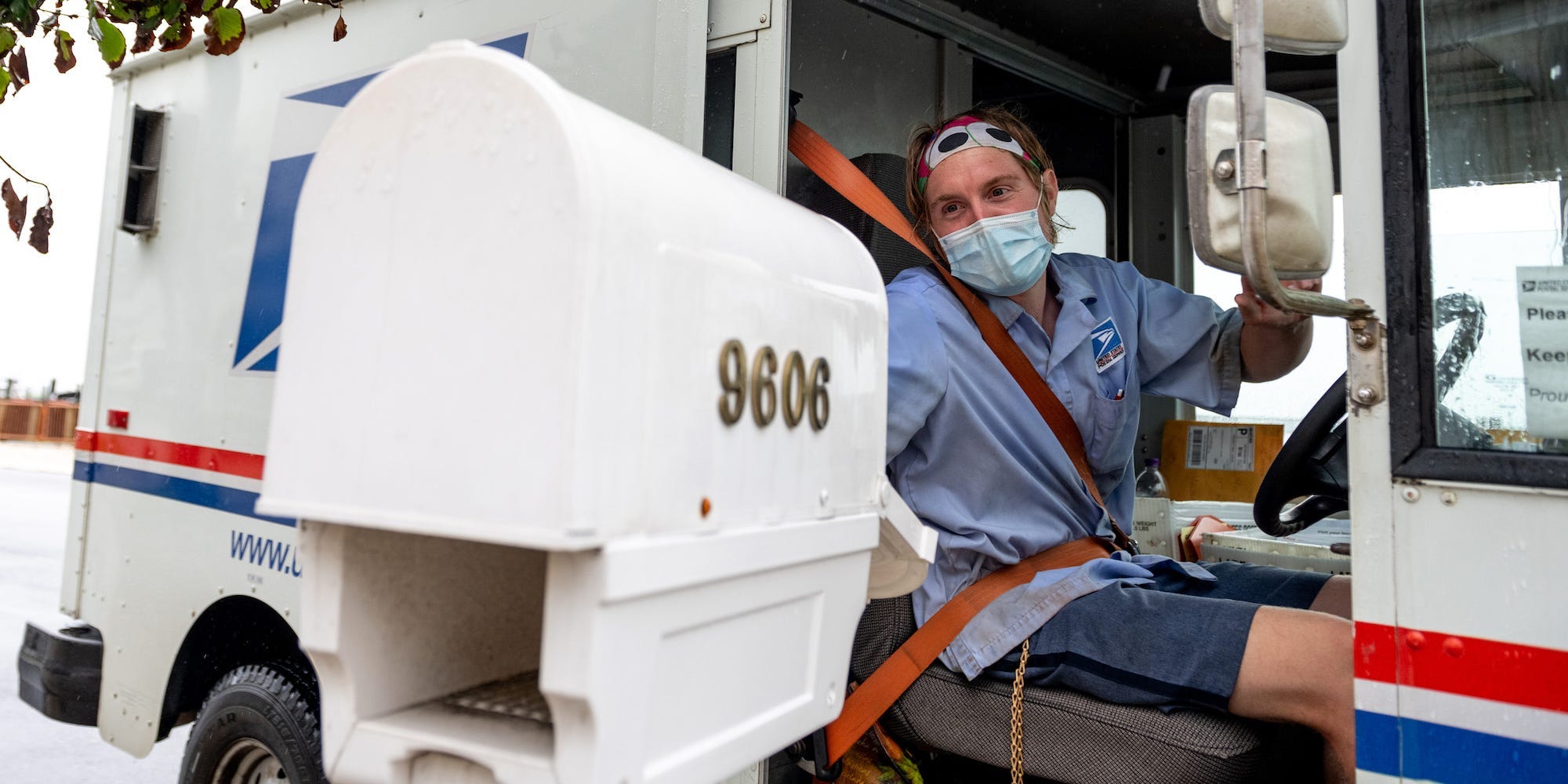- The United States Postal Service is currently suffering a financial crunch exacerbated by the COVID-19 pandemic.
- The decline in Americans using the Postal Service due to the pandemic accelerated the years-long reductions in first-class mail volume, and financial woes which were manufactured in part by Congress.
- Postmaster General Louis DeJoy is implementing cost-cutting measures including reductions in overtime and late trips that are causing service disruptions and delays in mail delivery in parts of the US.
- In order to ensure your vote is counted, be sure to request your November ballot now and return it over a week in advance, or consider returning your ballot in-person to your election office or a dropbox.
- Visit Business Insider’s homepage for more stories.
The United States Postal Service, an essential service millions of Americans use every day, is currently suffering a financial crunch exacerbated by the COVID-19 pandemic. The funding shortage has increased service disruptions and heightened fears that voters’ ballots may not get delivered on time in November.
On Thursday, President Donald Trump caused alarm by saying he would reject a $25 billion emergency funding grant to help the USPS stay afloat to intentionally sabotage mail-in voting. He later walked back his comments and said he would agree to sign a bill that included urgent funds for the service.
In addition to election mail and ballots, the US Postal Service also delivers essential documents, medication, and is a key service for small businesses to operate and send out packages.
As the carrier delivering packages to the last mile where it isn’t profitable for other private companies to deliver, the post office is especially key in rural areas. The Postal Service is also one of the most popular government agencies, with an April Pew Research Center survey finding that 91% of Americans have a favorable view of it.
How does the USPS work and how is it funded?
The US Constitution vested in the federal government the power to create "to establish Post Offices and Post Roads," with Benjamin Franklin appointed as the first-ever postmaster general in 1775. Its mission is to provide affordable mail and package delivery services to everywhere in the United States, no matter how remote or far-flung.
While the Postal Service is a government agency, it doesn't run off of taxpayer money, and operates entirely off of revenues from mail and package delivery as well as the other services it offers. It employs over half a million people, including 100,000 US military veterans.
Package delivery is an increasingly important and financially successful part of its model, and it has contracts with online retailers and e-commerce companies like Amazon to provide "last mile" shipping for its packages.
In recent months, the continued success of package delivery and substantial increases in package volume the agency is processing over 2019 levels has helped soften the blow of the sharp decline in first-class mail and improved the agency's financial outlook.
The significant decline in Americans using the Postal Service due to the pandemic accelerated the years-long reductions in first-class mail volume, which has fallen by over 30% in the past decade, and only exacerbated existing financial woes which were caused in part by Congress.
The Postal Service is especially burdened by 2006 federal legislation that required it to fund 75 years of employee pensions and health benefits in advance. The service saw its annual net losses double to $8.8 billion in 2019, and it currently has $160 billion in unfunded liabilities to those pre-paid pension and health plan obligations, according to the Washington Post.
The Postal Service now projects that it will run out of money by April 2021 if package volume returns to pre-pandemic levels and by October 2021 if package volume stays at 15% above pre-pandemic levels, Federal News Network reported.

How has the pandemic affected USPS?
The sharp reduction in mail delivery caused by the pandemic initially threatened to plunge the agency into even more dire straits, with the Postal Service reporting $2.2 billion in net losses in 2020's third quarter.
Trump, who has been hostile to the idea of expanding vote by mail, is opposed to any measures to help the Post Office. He has refused to sign the CARES Act stimulus package if it included a bailout for the agency, The Washington Post reported in April.
While the stimulus bill extended the Postal Service greater flexibility to borrow up to $10 billion from the federal government subject to Treasury Department approval, it didn't extend the agency any emergency government funding or forgive $11 billion in outstanding debt to Treasury, two of the measures that congressional Democrats called for.
The Post reported that while Congress initially came to an agreement on giving the Postal Service a $13 billion grant, Treasury Secretary Steve Mnuchin quashed the grant, telling lawmakers, "You can have a loan, or you can have nothing at all."

What are the recent policy changes impacting mail delivery and the election?
In June, former Postmaster General Megan Brennan retired and the Postal Service Board of Governors appointed Louis DeJoy, a North Carolina-based shipping and logistics executive and Republican political donor, as the next postmaster general. He had no experience working at the post office.
DeJoy's lack of experience within the Postal Service itself, his profile as a Trump donor, and his significant holdings in the post office's competitors immediately raised suspicion that his leadership could further undermine the agency.
In remarks to the Postal Service Board of Governors, DeJoy has emphasized that he's committed to keep providing timely mail delivery, including of election mail, while warning that "without timely legislative and regulatory reform, we will be forced to take aggressive measures to cut costs and bridge the divide."
Still, congressional Democrats and some Republicans are expressing concern to DeJoy about the sweeping changes and stark new delays taking place ahead of the election.
Senate Minority Leader Chuck Schumer and House Speaker Nancy Pelosi called on DeJoy to "quickly reverse his operational changes that have led to delays and service reductions for too many Americans and threaten to undermine our democracy" in a Friday statement.
On Friday, CNN reported that the Postal Service's inspector general has opened investigations both into the new changes and DeJoy's possible financial conflicts.
Here are some of the recent changes DeJoy has implemented to the Postal Service's operations to help the agency reduce costs, some of which are contributing to mail delays in many parts of the country. DeJoy and other top officials have said the changes are not meant to undermine the service, but rather to cut down on unnecessary transportation costs.
- The USPS is limiting overtime hours for mail carriers, according to guidance reported on by the Associated Press and the Washington Post. The limit will reduce how much mail carriers can deliver on a given day and will result in undelivered mail being left at distribution centers.
- USPS is also reducing "late trips" after-hours to deliver the maximum amount of mail each day and leave behind as little possible, the Post and Government Executive reported, which could further delay timely delivery.
- The Post Office is removing around 15% of its total high-speed processing letter machines from many locations, Motherboard reported.
- The agency has said the reduction in sorting machines, a now long-term process which began years before DeJoy took over, is in response to the overall yearslong decline in mail volume. But postal workers told Vice that even though mail volume has fallen, the removal of such sorting machines could hinder their ability to quickly process ballots.
- For many years, the Post Office allowed state and local election officials to pay a discounted bulk rate of 2o cents per envelope, instead of the usual cost of 55 cents per envelope, to have election mail be classified as first-class mail, which is delivered at a faster rate than marketing mail. But now the agency is advising officials to pay the full 55 cent rate to make sure mail is delivered at a first-class rate, which could put a strain on cash-strapped state and local governments.
- DeJoy recently significantly reshuffled the agency's top leadership, removing or reassigning 23 top executives, implemented a hiring freeze, and asking employees to retire early if possible, the Post reported.

What does it mean for my vote in November?
Dozens of states have expanded the availability and ease of voting by mail in response to the COVID-19, but the recent cost-saving measures at the Postal Service and ensuing mail delays have caused acute concerns that voters may not receive their ballots in time.
Officials at the top of the post office have assured officials and the public that the agency is prepared to handle a significant uptick in mail ballots, noting that it will still make up an overall small portion of their mail volume.
"On any given day, the Postal Service delivers more than 425 million pieces of mail, and our best estimates are that election mail will account for less than 2% of all mail volume from mid-September until Election Day," USPS executives David Williams and Thomas Marshall wrote in USA Today. "Given our available processing capacity, we can easily handle the anticipated increase in election mail due to the COVID-19 pandemic, without impact to on-time performance."
Still, with the entire US election infrastructure and the Postal Service under stress, it's important to do your part by requesting your ballot as soon as possible.
On Friday, The Washington Post reported that the post office has warned 46 states that their tight deadlines to request and return ballots increase the likelihood of voters not getting theirs back in time, a problem that election experts have been warning about for years. Of the states not sending all or most voters a mail-in ballot, 32 allow voters to request a ballot within seven days of an election.
- If you're sending your ballot back through the mail, the post office recommends giving your ballot at least a 15-day round trip to get from your local election offices to you and back. In order to have the highest chance of your ballot being counted, you should request your ballot now and mail it back weeks in advance.
- All 50 states allow voters to return mail ballots in-person to their local county elections office. In some states, you can also return to your ballot to a secure, monitored ballot dropbox, an option that lets you both avoid possible post office delays and long lines at the polls.
- 39 states have some form of early voting before election day, either in-person at a regular polling place, or by casting the equivalent of an absentee ballot in-person at your local elections office.
- In all but a few states that hold all-mail elections, you'll also have the option to vote in-person on election day. If you do, double-check your polling place, (it may have been moved due to the pandemic), wear a mask, and be prepared to wait in a longer line than usual.

